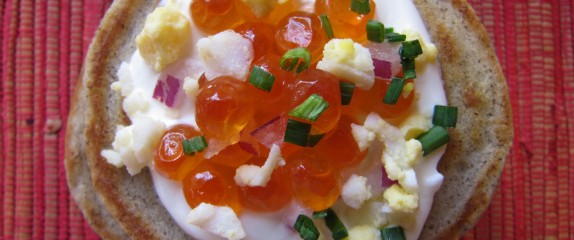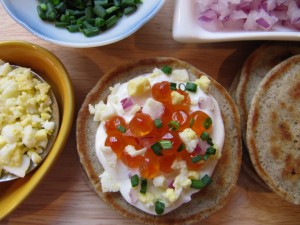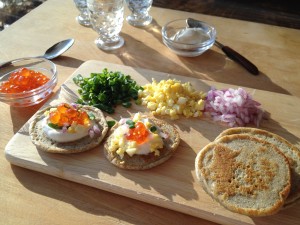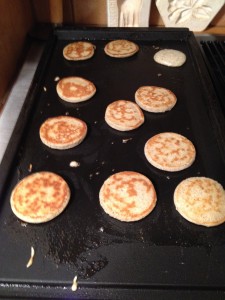Recipe for cocktail buckwheat blini
By Debra Samuels
| GLOBE CORRESPONDENT DECEMBER 24, 2013
Makes about 70 2-inch rounds
The raised pancakes blini are traditionally dipped into butter but can also be eaten with a variety of toppings, from a humble spoonful of jam to glistening orbs of black or red caviar with all the trimmings. “Blini are one of the oldest Slavic foods, dating back to the heathen tribes that worshipped the sun and created pancakes in its image,” writes Darra Goldstein, Williams College Russian professor, in “A Taste of Russia.” Buckwheat flour in the batter gives the little rounds a slightly speckled cast and a pleasant bitter and earthy taste. The batter is made with yeast, butter, sour cream, beaten egg whites, and heavy cream; it becomes smooth and luxurious after several risings (one rising can be done in the fridge overnight). “It is time-consuming, which is probably why I only make them once a year,” writes Goldstein in an e-mail. We made the blini into mini rounds, which are nontraditional. “The Russians never make cocktail-size blini,” writes Goldstein, who calls this “an American thing.” But she likes the smaller ones because they make perfect vehicles for smoked salmon and other toppings.
Serve with sour cream, black or red caviar, chopped pickled herring, chopped red onion, chopped fresh chives, chopped hard-cooked egg, smoked salmon, or jam.
| 1 | package active dry yeast |
| 2 | cups milk, heated to lukewarm |
| 1 | teaspoon sugar |
| ¾ | cup buckwheat flour |
| 5 | tablespoons butter |
| 3 | eggs, separated |
| ¼ | cup sour cream |
| ¾ | teaspoon salt |
| 1½ | cups all-purpose flour |
| ½ | cup heavy cream |
1. In a large bowl, dissolve the yeast in ¼ cup of milk. Let it sit for 2 minutes. Stir in the sugar and 1¼ cups more milk, stirring to break up any lumps.
2. Add the buckwheat flour and whisk briskly; there should not be any lumps. Cover the mixture and let rise in a warm place for 1 hour.
3. In a small saucepan, melt 2 tablespoons of the butter.
4. In a bowl, whisk together the butter, egg yolks, and sour cream. Add the butter mixture to the buckwheat mixture with the remaining ½ cup of milk, salt, and all-purpose flour; mix well until smooth. Cover the bowl with a cloth and set aside in a warm place to rise for 2 hours. (At this point, you can refrigerate the batter overnight; the following day bring the batter to room temperature before proceeding.)
5. In an electric mixer, beat the heavy cream until stiff. In another bowl, beat the egg whites until stiff but not dry. Fold the whites into the cream. Fold the cream mixture into the batter. Let the batter rest for 30 minutes (if the batter seems too thick at this point, add a little warm milk, 1 tablespoon at a time).
6. In a cast iron skillet or griddle, on medium heat, melt the remaining 3 tablespoons of butter. Pour the butter into a bowl. Have a pastry brush on hand.
7. Use 1 tablespoon of batter for each round (a mini ice cream scoop works well), fitting as many into your skillet as it will hold, leaving 1 inch between rounds. Scoop the batter from the top each time so that the rest doesn’t fall.
8. Cook rounds for about 2 minutes or until bubbles appear on the surface. Use a spatula to turn the pancake and cook the other side until faintly browned. Set it in a deep, warm dish and cover with a clean kitchen towel. Repeat with remaining batter, brushing pan with butter each time.
NOTE: To freeze: Set a large sheet of foil on the counter. Add a layer of blini to the middle of the foil, layer with waxed or parchment paper, and continue layering, separating blini with paper. End with paper. Wrap the extra foil over the packet, seal, and freeze. To reheat: Without thawing the blini, remove layers of paper from the foil packet, reseal packet, and reheat in a 350-degree oven for 15 minutes. Debra Samuels. Adapted from“A Taste of Russia”















 Debra Samuels, bestselling author, food writer and cooking instructor,
Debra Samuels, bestselling author, food writer and cooking instructor,